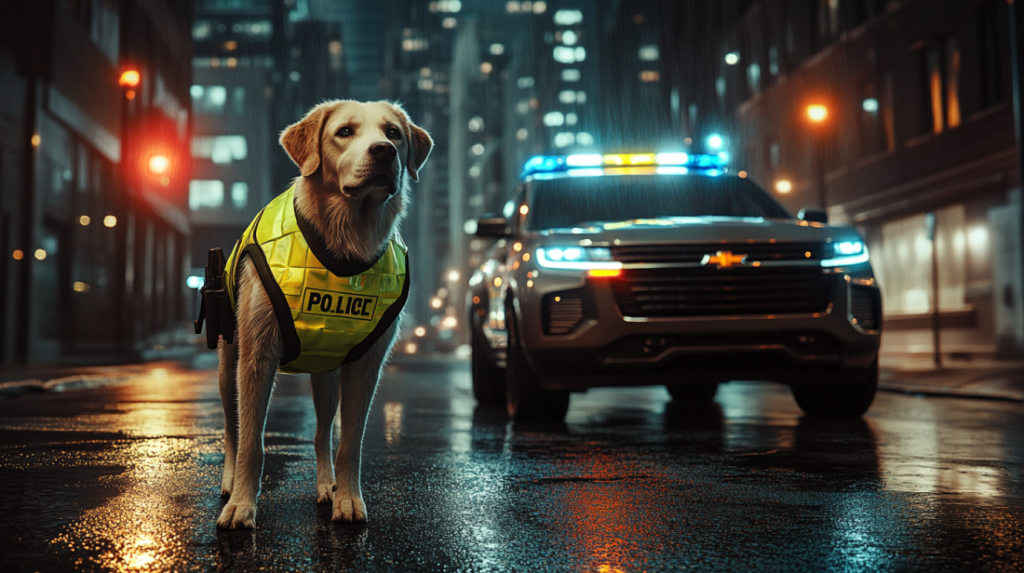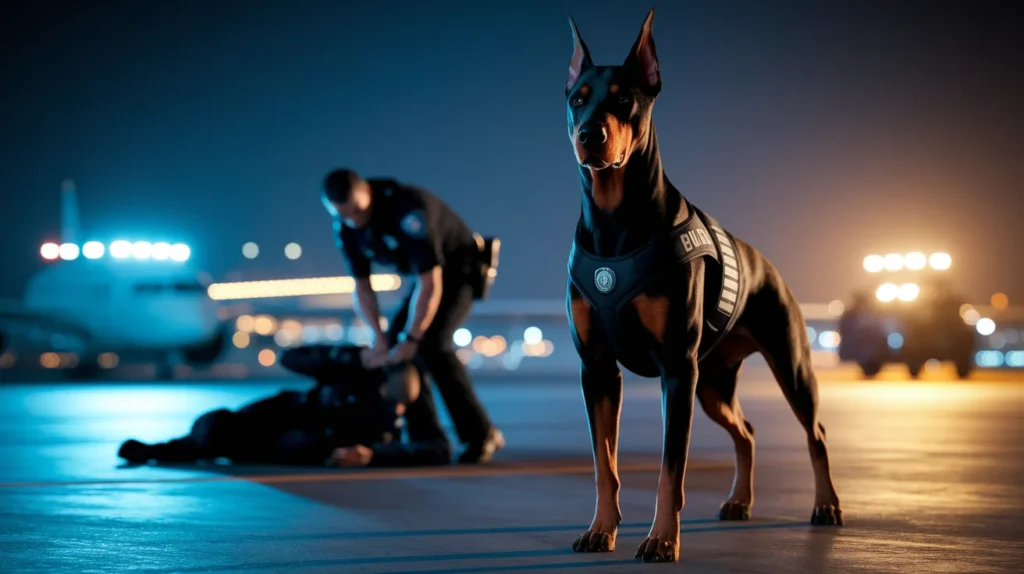Discover 5 shocking police dog news stories that made headlines this week, from heroic rescues to groundbreaking K9 technology advancements in law enforcement.
In the world of law enforcement, police dogs serve as invaluable partners to their human handlers, demonstrating exceptional skills in tracking, apprehension, and detection. These highly trained K9 officers often find themselves at the center of remarkable incidents that showcase their intelligence, bravery, and unwavering loyalty. This week, several police dog news stories have captured public attention, highlighting both the heroic actions and occasional controversies surrounding these four-legged officers. From extraordinary rescues to technological advancements in K9 training, these recent developments offer fascinating insights into the evolving world of police canine units. Join us as we explore five shocking police dog news stories that made headlines this week, revealing the complex and often surprising reality of K9 policing in today’s world.

Table of Contents
1. Hero K9 Officer Locates Missing Child in Mountainous Terrain
The Desperate Search Begins
When seven-year-old Ethan Miller wandered away from his family’s campsite in the Blue Ridge Mountains last Sunday, a frantic search operation immediately commenced. After 12 hours with no signs of the child, local authorities called in K9 Officer Rex, a four-year-old German Shepherd with the county’s specialized search and rescue unit.
Rex’s Remarkable Tracking Abilities
Despite challenging weather conditions including intermittent rain and decreasing temperatures, Rex picked up Ethan’s scent from a discarded jacket and tracked the child through nearly three miles of dense forest and rocky terrain. K9 handler Officer James Peterson described the difficult conditions:
The mountain landscape created swirling wind patterns that made scent tracking exceptionally challenging. Rex had to constantly readjust and verify the scent trail, which speaks to his incredible training and natural abilities.
The Emotional Reunion
Rex eventually located Ethan in a small ravine, where the boy had sought shelter from the rain. Despite being cold and frightened, Ethan was uninjured—a miraculous outcome considering the dangerous terrain and overnight exposure.
County Sheriff Diana Williams praised the K9’s performance: This police dog news story exemplifies why our K9 program receives continued funding and support. Rex accomplished in hours what might have taken days with traditional search methods, potentially saving Ethan’s life.
The Science Behind K9 Tracking Success
Rex’s successful tracking showcases the remarkable olfactory capabilities of police dogs:
| Capability | Human | Police Dog |
| Olfactory Receptors | 6 million | 225-300 million |
| Scent Detection Range | Limited to immediate vicinity | Up to 1-2 miles under ideal conditions |
| Scent Memory Capacity | Limited | Can retain and distinguish hundreds of unique scents |
| Scent Detection in Adverse Conditions | Severely limited | Still functional in rain, wind, and extreme temperatures |
This scientific advantage explains why K9 units remain crucial in search and rescue operations, even as technology advances.

2. Groundbreaking Body Camera System Developed Specifically for Police Dogs
Revolutionary Technology for K9 Units
In one of the most innovative police dog news developments this week, tech company SafeGuard K9 unveiled a specialized body camera system designed specifically for police dogs. This breakthrough technology addresses the unique challenges of capturing footage from a canine officer’s perspective.
Technical Specifications
The K9-Cam system features:
- Stabilization technology that compensates for the natural movement of the dog
- Infrared capabilities for low-light operations
- Shock and water-resistant housing
- Live-streaming capabilities to handler devices
- Lightweight design (under 8 ounces) to avoid impeding the dog’s movement
- 8-hour battery life with quick-swap capability
Legal and Ethical Implications
This technological advancement raises important questions about evidence collection and transparency in K9 operations. Legal experts suggest that footage from these cameras could:
- Provide crucial evidence in criminal cases
- Protect handlers and departments from liability claims
- Document K9 behavior for training purposes
- Address concerns about appropriate use of police dogs
Attorney Lawrence Chen, who specializes in law enforcement technology, commented: “This represents a significant advancement in police accountability. Previously, K9 deployments lacked the same level of documentation as human officer actions. These cameras help close that gap.”
Initial Field Testing Results
Initial tests in three police departments show promising results:
- 43% increase in usable evidence collection during K9 deployments
- 27% reduction in contested K9 apprehension cases
- 68% of handlers reported improved operational awareness
The technology is expected to be available nationwide within six months, potentially transforming how K9 units operate and are supervised.
3. Retired Police Dog Prevents Armed Robbery While Off Duty
From Service to Civilian Life
Seven-year-old Maverick, a Belgian Malinois who served five years with the Metropolitan Police Department, was adopted by former handler Officer Ryan DeMarco upon retirement due to a minor hip injury. While Maverick had transitioned to civilian life, his training and instincts remained sharp—a fact that would prove fortunate during a routine visit to a local convenience store.
The Unexpected Incident
On Tuesday evening, DeMarco and Maverick stopped at a corner store when an armed suspect entered and demanded cash from the register. While DeMarco remained still as instructed, Maverick—despite not wearing any police identification—sensed the threat and responded.
Trained Response in a Civilian Context
Store owner Priya Patel described the scene: “The dog was completely calm until the robber became aggressive and shoved his gun toward my cashier. In an instant, the dog went from relaxed to completely focused. He positioned himself between the gunman and customers without any command.”
Witnesses report that Maverick’s defensive posture and warning growl caused the suspect to hesitate, creating crucial seconds for DeMarco to identify himself as a police officer. The suspect fled but was apprehended two blocks away by responding officers.
The Legal Considerations
This unusual police dog news incident raises interesting questions about retired police dogs. Unlike active-duty K9s, retired police dogs have no official status in most jurisdictions. However, their training and capabilities don’t simply disappear upon retirement.
Legal expert Camila Rodriguez explains: “This case exists in a fascinating gray area. Maverick wasn’t deployed as a police asset, yet his police training directly contributed to preventing a violent crime. This highlights the need for clearer policies regarding retired police animals.”
Community Recognition
The local community has rallied around Maverick, with the mayor planning to present a special civilian commendation next week. The story has sparked renewed interest in police dog adoption programs nationwide.
4. Controversy Over New Virtual Reality Training for Police Dogs
Pushing Boundaries in K9 Training
In what may be the most controversial police dog news story this week, researchers at Central State University’s Veterinary Science Department have developed a virtual reality system designed specifically for police dog training. The program aims to expose K9 officers to realistic scenarios without putting them in physical danger.
How the Technology Works
The specialized system includes:
- Custom-fitted headsets designed for canine anatomy
- Scent-emitting devices that correlate with visual stimuli
- Spatial audio that mimics real-world sound patterns
- Pressure-sensitive flooring that adjusts to simulate different terrains
- Reward mechanisms integrated into the virtual environments
Dr. Elena Vasquez, lead researcher, explains: “Dogs process visual information differently than humans, so we’ve designed a system that accounts for their unique perception, including their wider field of vision and different color sensitivity.”
The Ethical Debate
The technology has sparked intense debate among animal welfare advocates, K9 trainers, and police departments:
Supporters argue:
- Reduces physical stress on dogs during training
- Allows for controlled exposure to dangerous scenarios
- Potentially reduces training injuries
- Enables standardized training metrics across departments
Critics contend:
- Potential for sensory confusion or distress
- Unknown long-term effects on canine cognition
- Concern about diminished real-world practical experience
- Questions about whether dogs can distinguish virtual from actual threats
Expert Perspectives
Renowned animal behaviorist Dr. Marcus Thompson expressed reservations: “Dogs rely heavily on their integrated sensory experience. We simply don’t know enough about how this technology might affect their psychological development or performance in actual field conditions.”
Meanwhile, Police Lieutenant Sophia Wright sees potential benefits: “If this can help prepare our K9s for dangerous situations while reducing their exposure to harm during training, it deserves serious consideration.”
The debate highlights the complex balance between technological innovation and animal welfare considerations in K9 training.
5. DNA Evidence from Police Dog Bite Leads to Exoneration in Decade-Old Case
A Surprising Forensic Breakthrough
In a remarkable development that has shocked legal and law enforcement communities, DNA evidence preserved from a police dog bite has led to the exoneration of Marcus Johnson, who served nine years for an armed robbery he didn’t commit.
The Original Case
In 2014, Johnson was convicted primarily based on eyewitness testimony and circumstantial evidence after a police K9 named Storm apprehended a suspect fleeing from an armed robbery. The dog’s bite left sufficient DNA evidence on his handler’s equipment, which was preserved in evidence storage but never fully analyzed with the technology available at the time.
New Forensic Techniques
Recent advances in touch DNA analysis allowed forensic scientists to extract and amplify minute DNA samples from the K9 handler’s glove, which had come into contact with the suspect during the apprehension. The Innocence Project, which took on Johnson’s case in 2022, requested the reexamination of all evidence using these new techniques.
The Shocking Discovery
The results definitively excluded Johnson while matching another individual already serving time for similar crimes in a neighboring state. This police dog news revelation has prompted a review of at least seven other cases where K9 apprehensions played a significant role.
Implications for Police Dog Evidence
This case highlights both the potential and limitations of evidence related to police dog deployments:
| Aspect | Previous Understanding | Current Recognition |
| Bite Mark Evidence | Considered primarily for medical documentation | Now recognized as potential DNA collection point |
| Handler Equipment | Rarely preserved for DNA evidence | Increasingly preserved using anti-contamination protocols |
| K9 Tracking Accuracy | Often presented as definitive in court | Now subject to more rigorous scientific validation |
| Cross-Contamination Risks | Poorly understood in K9 contexts | New protocols being developed to preserve evidence integrity |
Forensic scientist Dr. Aisha Williams notes: “This case demonstrates how evidence from police dog interactions, previously overlooked, might contain crucial information. It’s changing how we think about evidence collection during K9 deployments.”
Systemic Review Underway
The district attorney’s office has announced a comprehensive review of cases involving K9 evidence, potentially affecting dozens of convictions. Legal experts suggest this could represent a significant shift in how courts view and evaluate police dog evidence.
The Evolution of Police Dog Units: Training and Capabilities
Modern K9 Selection and Training
Today’s police dog news undergo rigorous selection and training processes that exceed historical standards. Modern police K9s typically:
- Begin specialized training between 12-18 months of age
- Undergo 6-12 months of initial training before certification
- Receive 16-20 hours of ongoing training monthly throughout their careers
- Specialize in specific functions (apprehension, narcotics detection, explosives detection, etc.)
- Learn advanced techniques like tactical breathing to remain calm in chaotic situations
Specialized Units and Capabilities
The field of police dog news deployment has become increasingly specialized, with distinct types of K9 units:
- Patrol Dogs: General-purpose K9s trained in tracking, apprehension, and evidence recovery
- Detection Dogs: Specialized in identifying specific substances (narcotics, explosives, firearms)
- Search and Rescue Dogs: Focused on finding missing persons in various environments
- Electronic Storage Detection Dogs: A newer specialty trained to locate hidden electronic devices
- Human Remains Detection Dogs: Trained to locate deceased individuals
- Currency Detection Dogs: Specialized in finding large quantities of cash
The Human-Canine Partnership
At the core of every successful K9 unit is the bond between handler and dog. Officer Maria Sanchez, a 12-year K9 handler, explains: “The relationship goes far beyond basic commands. We develop a form of communication that’s almost intuitive. I can read subtle changes in my partner’s behavior that tell me things no technology could detect.”
This symbiotic relationship enhances the effectiveness of police dog units in ways that technology alone cannot replicate.
FAQ
How long do police dogs typically serve before retirement?
Most police dog news serve between 6-9 years before retirement, depending on their health, working role, and individual performance. Detection dogs often have longer careers than apprehension dogs, as the physical demands are generally less strenuous. Retirement decisions are typically made by veterinarians and K9 unit supervisors based on the dog’s physical condition and working ability.
What happens to police dogs after they retire?
Approximately 90% of retired police dogs are adopted by their handlers. When this isn’t possible, departments typically have waiting lists of approved adopters, often including other officers or carefully screened civilians with experience handling working dogs. Most departments now have formal retirement programs that ensure medical care and appropriate placement for their K9 veterans.
Are certain dog breeds better suited for police work?
While German Shepherds, Belgian Malinois, and Dutch Shepherds remain the most common breeds for general police work, different specialties may favor different breeds. Labrador Retrievers and Springer Spaniels excel in detection roles, while Bloodhounds are prized for their tracking abilities. Breed selection depends on the specific needs of the department and the intended role of the dog.
How accurate are police dogs in detecting substances?
Research indicates that properly trained police dog news can achieve accuracy rates between 90-95% in controlled testing environments for narcotics detection. However, real-world conditions can affect performance. Factors like environmental distractions, handler influence, and working duration can impact accuracy. Ongoing training and certification are essential to maintaining high performance.
Do police dog news understand the difference between work and off-duty time?
Yes, most police dogs are specifically trained to recognize when they are “on duty” versus when they are at home. Equipment like special collars, harnesses, or verbal cues signal to the dog when they are working. This distinction helps the dogs maintain appropriate behavior in different contexts and reduce stress by clearly defining when they should be in “work mode.”
How much does it cost to train and maintain a police dog?
The initial acquisition and training of a police dog typically costs between $12,000-$15,000, though specially imported dogs with existing training can cost up to $45,000. Annual maintenance costs—including specialized veterinary care, food, equipment, and ongoing training—average $8,000-$12,000 per year. Most departments consider this investment cost-effective compared to the dog’s contribution to law enforcement capabilities.
Take Better Care of Your Own Canine Companion
While police dogs receive specialized training and care, all dog owners can benefit from understanding canine behavior and proper training techniques. For expert guides on dog training, nutrition, and healthcare, visit BlithePet for comprehensive resources designed for both new and experienced dog owners.
Our team of veterinarians and animal behaviorists regularly publishes updated content on the latest advances in canine care, helping you give your four-legged family member the best possible life.
Conclusion
The world of police dog news operations continues to evolve, balancing tradition with innovation. This week’s police dog news stories illustrate the remarkable capabilities of these animals while also highlighting emerging challenges and controversies. From heroic rescues to technological breakthroughs, K9 units remain at the forefront of law enforcement, adapting to new demands and expectations.
As we’ve seen through these five shocking stories, police dog news contribute to public safety in diverse and sometimes unexpected ways. Their unique abilities—enhanced by training and technology but rooted in natural canine instincts—continue to make them irreplaceable partners in modern policing.
What are your thoughts on these recent developments in police canine units? Have you had any memorable encounters with police dog news in your community? Share your experiences and perspectives in the comments below!







